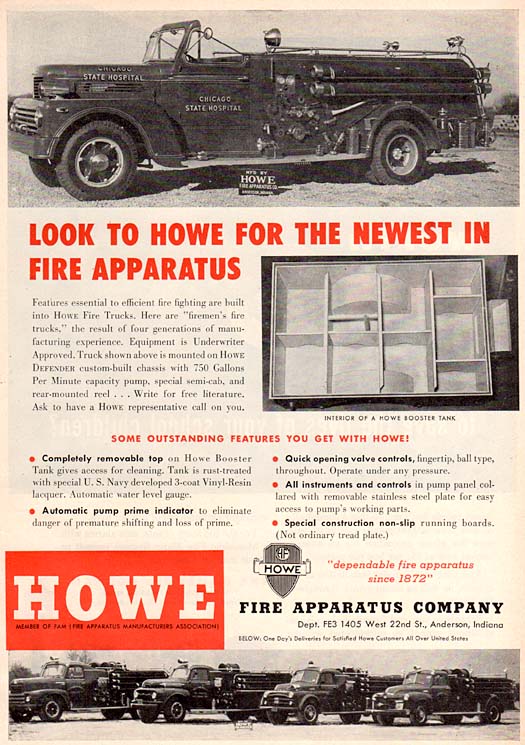Thanks to Firegeezer.com for digging up this old ad from the Howe Fire Apparatus Company. It features an engine from the Chicago State Hospital in a November 1953 ad from Fire Engineering Magazine.
Do we have some readers that can expound on this engine or the fire department?
Howe Fire Apparatus Office. Howe manufactured fire trucks and equipment for 66 years in Anderson. In 1978, the company closed the Anderson plant and moved to Roanoke, Va.

1953 fire truck ad from Fire Engineering Magazine for the Howe Fire Apparatus Company.
An interesting article on the Howe Company was recently published in the Herald Bulletin Online.
By Beth Oljace Anderson Public Library
The year 1871 was a disastrous year for fires in the United States.
On Oct. 8, 1871, the Great Chicago Fire destroyed more than three square miles of the city’s north lakefront, killed hundreds of people and leaving a third of the city homeless. On the same day, three cities in Michigan — Manistee, Holland and Port Huron — also suffered huge fires.
The fifth fire that day was the most devastating of all. A firestorm ignited the drought-plagued country around Peshtigo, Wis., burned more than 1 million acres and killed more than 1,000 people. Americans were more than aware of the dangers of fire. It was a good time for B.J.C. Howe to start his business.
B.J.C. Howe had perfected and patented a piston pump fire wagon, the first of its kind, and he began to sell it in 1872. The pump could be operated by a team of 20 men or by the team of horses that had drawn it to the fire. It was a highly efficient water thrower. The design of the pump was so good that versions of it were still being made and used 100 years later.
Howe Fire Apparatus located first in Indianapolis and spent nearly 50 years there. The Howe family’s country home served as the business’ test kitchen. Frequently, new pump units would be tried out on the grounds. (Mrs. Howe must have been a tolerant woman.) The family also maintained a good relationship with the city by servicing its equipment for them. Before summer holidays, one of the Howe sons would visit all the horse-watering troughs in the city to make sure that the well pumps were in working condition. He would also visit fire departments throughout central Indiana to make sure that their Howe pumpers were working properly.
In the 1960s, Howe bought the Oren Roanoke Corp. in Virginia and the Coast Apparatus Company near San Francisco, Calif. They provided the company with regional outlets on the East and West coasts and allowed the company to run three small factories, which was a better approach for a customized service. At that time the Anderson factory had 120-150 workers, creating 140 customized trucks a year.
In 1975, the government eliminated revenue sharing funds for the purchase of fire equipment. This, and other changes in the economy, slowed the purchase of Howe equipment. In 1976, the company was acquired by Grumman Industries of New York. When things did not improve, the company made the decision to close the Anderson factory. Howe Fire Apparatus in Anderson ceased operations on December 15, 1978.
Howe Fire was a four-generation family business. B. J. C. Howe retired from the business in the early 1890s and left it to his three sons, who ran operations until the Depression. The sons of L.M. Howe managed the company into the ‘40s. One of them remained as chairman of the board until the 1970s and his sons were president and plant superintendent.
Manufacture of Howe Fire Apparatus equipment was moved to the Virginia plant after Howe’s Anderson plant closed in 1978. Howe Fire equipment was manufactured until 1982. Grumman Allied Industries, the company which purchased Howe, was absorbed into Northrop Corp. in 1994 and is still in business.
These are only excerpts, read the entire informative article at the link above.





























